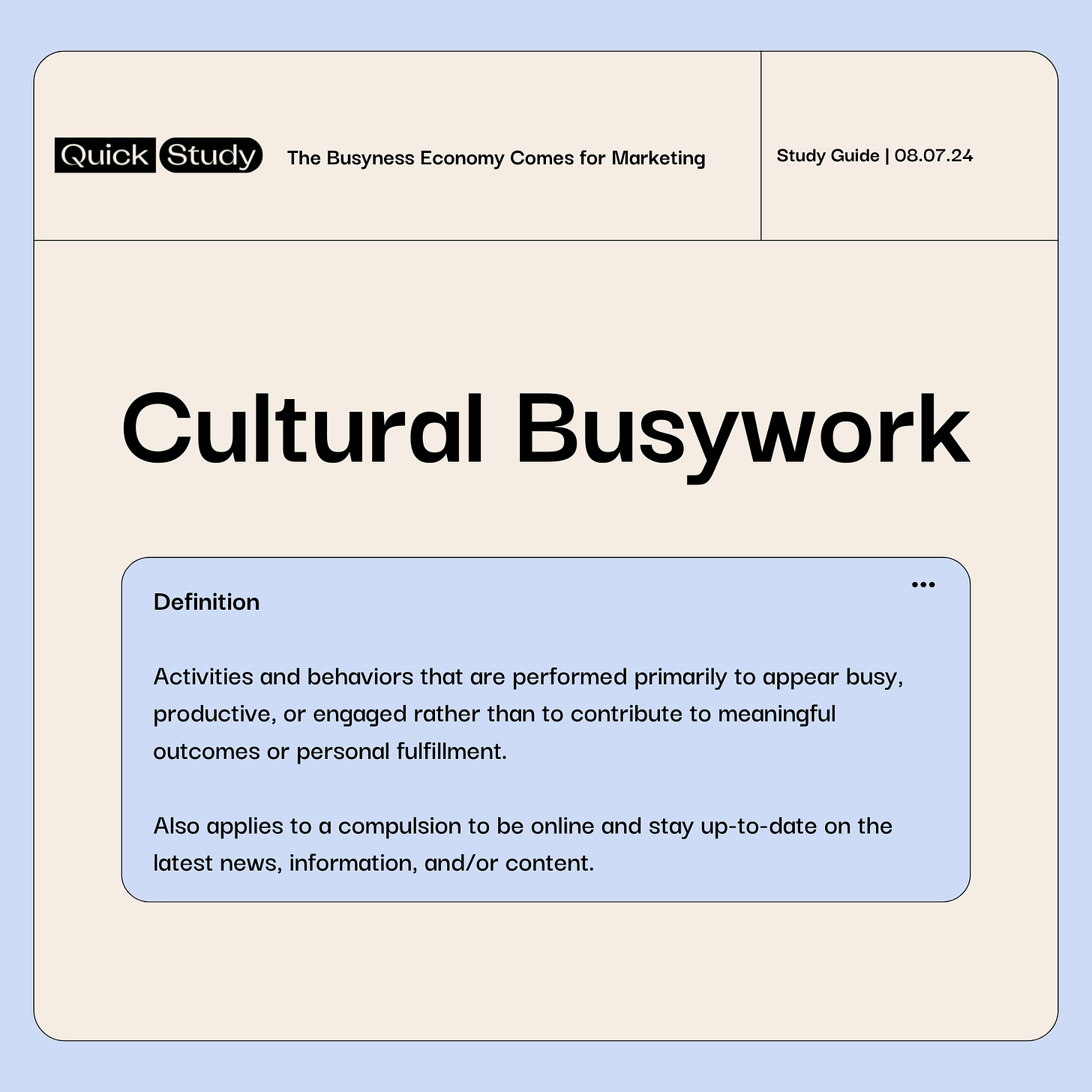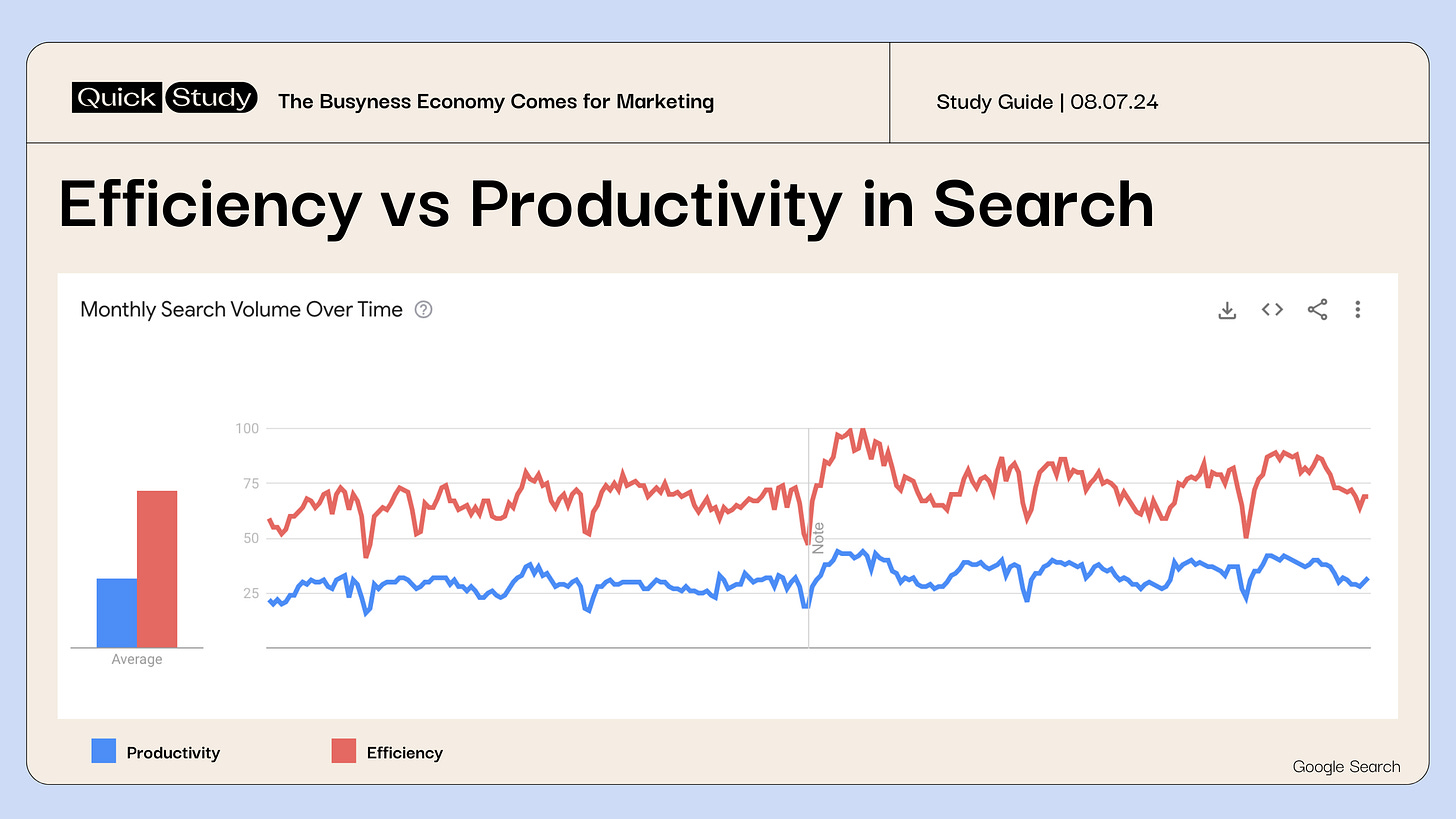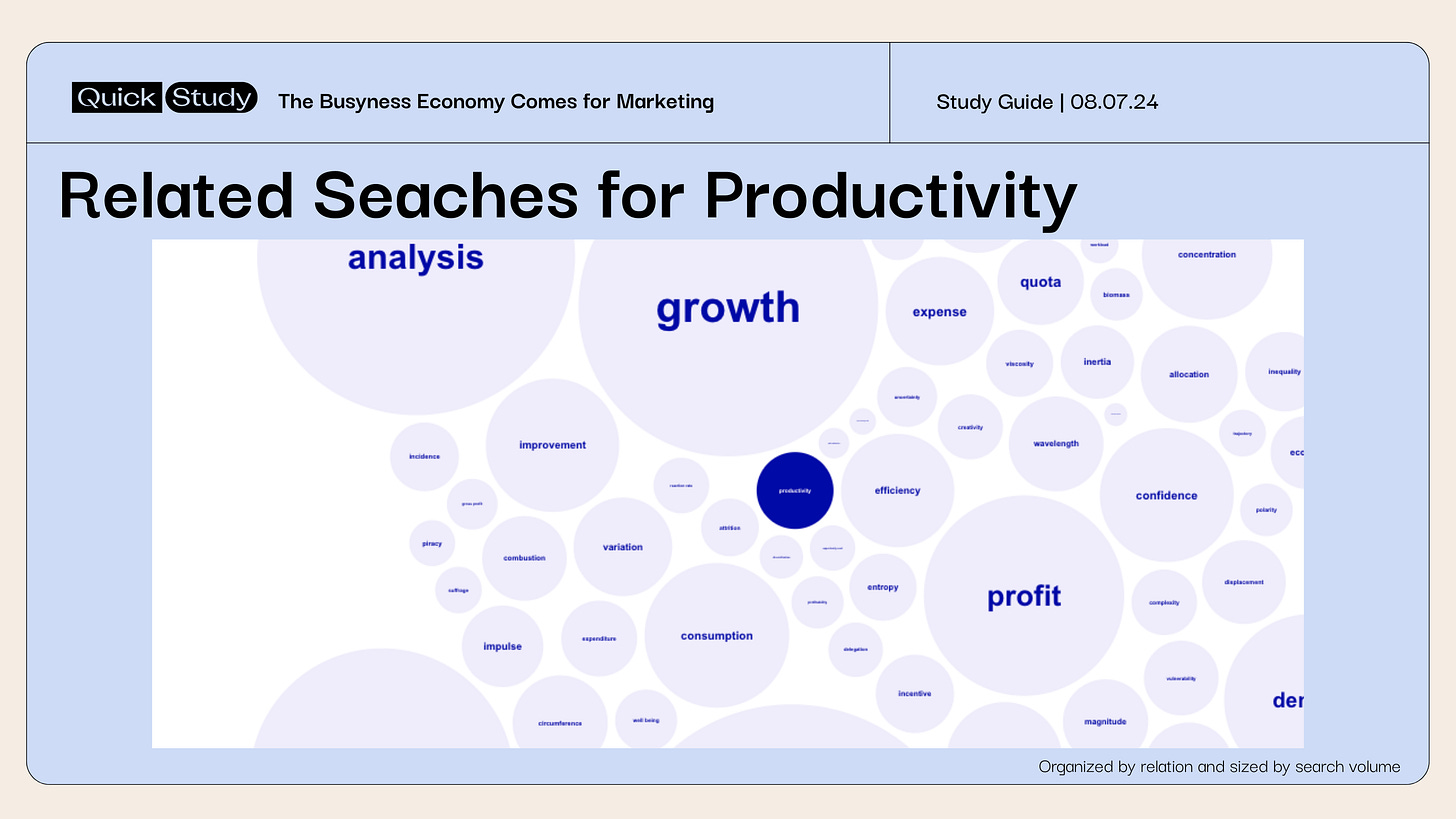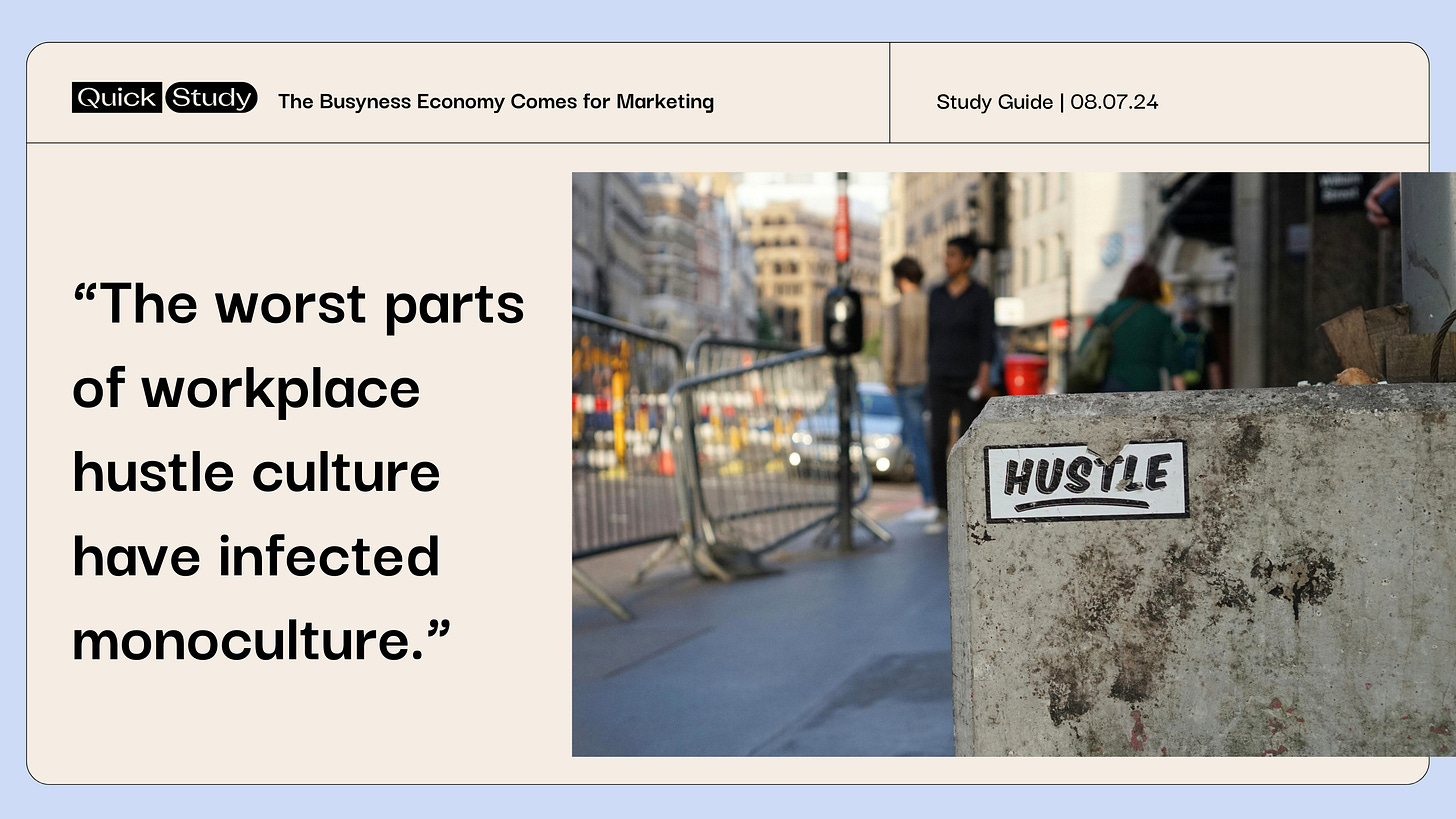The Busywork Economy Comes For Marketing
The quest for optimization has transcended business and infected mass culture. Now brands need to decide if they’re in the business of creating homework or adding actual value.
Hey. Hi. Hello. This is The Other 90, a blog about strategy from your friends at Quick Study. Today’s Study Guide takes about 12 minutes to read. You can also view it on our website.
If you’re behind on planning for the fall or already looking ahead to 2025, we’re here to help. Reach out to us at hello@quick.study and we’ll custom-build a sprint that gets you an effective, actionable strategy. For example, we’ve just wrapped up a project with a major tech brand, helping them better understand the world of their audiences and developing a comms strategy & phased rollout for an upcoming campaign.
Let’s start here:
The “where” of a workplace has been a public point of contention for a little over four years now, with WFH and hybrid schedules becoming a permanent part of the lexicon (not to mention the ongoing question of how “hot” a desk may or may not be). But the “what” of the workplace, the daily check-ins, statuses, stand-ups, and 1-on-1s, has largely chugged along through pandemic, protests, Great Resignations, and more. If anything, we as a society are actually doubling down on work; in a July essay assailing meeting culture, Derek Thompson at The Atlantic notes a Microsoft study that found workers have tripled the time spent in meetings since 2020. “I think we’ve hit the high point of max human inefficiency in white-collar work,” a VP at Microsoft told Thompson. “It sometimes seems as if the modern worker spends more time talking about work than actually working.”
There are some plausible explanations for this. More people working from home means less connection in person, which means more conversations must be scheduled versus spontaneous. Companies are pressured to make rapid decisions in an ever-changing world, demanding constant readiness to react. You could list many other justifications that defend the ways we work, but there is one truth that rests above them all: People have a compulsion to fill their calendars, and it doesn’t matter what they fill it with.
For decades, social scientists have been tracking the increase of what has come to be known as “time poverty” in the US and abroad, specifically in its relation to the workplace. Framed as a culture – and sometimes even a cult – of busyness, study after study have documented the rise of busyness as a status symbol and something to be revered. Research has found people would prefer electric shocks or something as basic as disassembling and reassembling bracelets to avoid having to sit still. So it’s not surprising then that our workplaces have capitalized on this need for action, however brainless or minute that action may be, in order to keep us feeling content. It doesn’t matter what, exactly, is being accomplished in the workplace, it just matters that it feels like something is happening and that others perceive the effort being put into doing it.
That same aversion for idleness exists beyond the workplace. The content we consume daily and the mindlessness with which we consume it has been branded slop, brain rot, and more. Many currently blame the rise of AI for this, but that’s more a symptom than the cause. In reality, it merely fills a void we’ve created in our quest for constant engagement. As Rob Horning weighed in recently, “Is there material we are content to call “content” that isn’t “slop” made to fill bottomless feeds?”
The bottomlessness of feeds is the perfect example of the situation we find ourselves in. According to GlobalWebIndex, “filling spare time” is the second most popular reason for using social media, behind only “keeping in touch with friends/family” and well ahead of things like reading the news, following sports, and finding things to buy. Whether it’s doomscrolling or chasing hope, we’re trapped in a cycle where being mindlessly occupied trumps genuine engagement. It’s as if the worst parts of workplace hustle culture have infected monoculture: the need to appear active and busy at all times, the inefficient ways we consume and spread information, the lionization of those who post more, or better, or faster, regardless of accuracy.
This is all part of the Busywork Economy. Our lives are spent turning total engagement time into a game to be won regardless of what’s being learned. It’s bigger than AI’s crap content thanks to AI, it’s actually innately human, and it’s infecting everything we make and like. As marketers become obsessed with brand universes and building communities, they too fall prey to this trap. Who is this busywork for? What happens when we optimize for business, not for people? And what might it look like to prioritize value over slop?
The Busywork Economy rewards optimization, not originality
“Optimization is slowly killing the internet.
The bad news is that the internet is never going back to the way it was. It’s too late. The rules of the current game are known and the game is too easy to play.
When things become easier – anyone can make a website on Squarespace, anyone can produce images in Midjourney, practically anyone can start a startup, whatever – the vast majority of the things produced the easy way are total dogshit. When algorithms embrace the dogshit, or the dogshit contorts itself to please the algorithm, the whole visible internet turns to dogshit.
Good content and good businesses get drowned out by good optimizers, and that’s bad for us all.”
- “Make the internet fun again”, Not Boring, July 2024
There is a difference between productivity and efficiency, but we tend to ignore it. The workplace studies referenced earlier have found that people get labeled successful for being productive, regardless of how good the output is. When we reward one in spite of the other, it’s no wonder people start to get them confused. Our Google search trends tool Glimpse shows a correlation in searches between productivity and efficiency. They both dipped in 2020 and 2021, but returned to pre-pandemic levels in 2022. Efficiency is searched more than productivity, but both are currently on the rise year over year.
We can learn more by zooming out and looking at related searches and their volume. For example, people searching those terms frequently also search for profit and growth, and do so at a higher volume than most other related searches. There are echoes here of the productivity paradox and the recognition that better tech doesn’t necessarily mean better outputs or results.
The appearance of activity becomes linked to the assumed result of it: success. Our optimization-minded brains inherently tie more input to more output, even though the correlation doesn't always exist (as we’ve seen historically in the productivity (or Solow) paradox).
In the content world, this misplaced march of busywork toward a profitable result drives creativity away from the unique and into the arms of sameness. “Intentional or not, the modern era has been, in many ways, a quest for sameness: globalised markets, monoculture crops, standardised protocols,” wrote Scott Doorley and Carissa Carter for dezeen in July. “We need some sameness. It's efficient, it puts food on the table, helps people coordinate and helps ideas spread. Standards can be useful. It's convenient that within countries and regions the shape of power outlets is the same, and then glaringly annoying when you bring an electronic device overseas and need to find an adapter. But sameness,” they went on to explain, “also spreads trouble…”
Take the world of fashion coverage, for example. The speed of trend cycles and never-ending sales periods have manufactured an entire ecosystem of affiliate-link-funded reporting on the looks of the day. These creators, editors, and influencers tend to coalesce around the same stories, creating an extremely repetitive and circular narrative. In this sort of environment, things are only “out” until someone says they are back “in” loud enough for others to repeat the assertion (see the double G Gucci belt for example). But for a brief 10 days or so in July, it all came to a head, as fashion curators and influencers wrestled with the reality that they’ve all started to look and sound the same in a race to become the most optimized.
“I … have been thinking about hype and wondering whether the hoopla that forms around an item is the result of the designer who makes the thing or the editor-into-content creator/influencer funnel that rallies around the designer,” wrote Leandra Cohen about Mary Janes but also fashion in general. The conversation continued across Substacks and some of it also took an exit ramp into the realm of underconsumption core. After a week or so the noise died down, and instead of being a watershed moment around how hype in fashion is created, this type of retrospective thinking only served to drive its own content cycle in the funnel, thus proving that it is, in fact, the tail wagging the dog.
Soon the busywork of following this thread of criticism was over, everyone had gotten to publish their peace, and bus(y)ness was back to normal. The episode proved we don’t like looking our busywork in the eye, at least not for long. It also showed that our self-awareness and discomfort with the creeping sameness is no match for the optimized feeds we need to feed and be fed by.
Brands are too eager to contribute to the slop
“I’m not here to criticize others for how they process or react to breaking news events, but I think many people chronically online could benefit from some intentional off-screen time during big events. The choice in this though is ultimately up to the individual.
This isn’t to say that you shouldn’t stay informed, but the line between staying informed and obsessing is often blurry for many. Learning how to stay on the right side of that line takes time and intentional effort.
So, the next time a breaking news event dominates your feed, I encourage you to take a step back and ask yourself:
Do I really need to know this right now?”
- “It is time to slow down”, Clicked, July 2024
Brands long ago decided that winning meant contributing to the Busywork Economy. They ask consumers to jump through hoops all the time to make the brand’s job easier - download apps, sign up for emails, follow the brand on social media. As marketers, we’ve developed complex content strategies and channel ecosystems that catch consumers in our web and do whatever we can to make them stay as long as they can. These choices can be gussied up with different language, but too often they serve to increase the path from engagement to sale versus shorten it. They create an expectation that people want to come spend time in the world of the brand, and imply that more time spent equals a richer experience that’s worth the busywork.
The recent uptick in discourse around “brand universes” is the perfect example of how this works. On its face, brand universes are a useful internal way of thinking about storytelling. It’s a mentality that promotes connecting the dots and consistency in narrative. They are a smart reskinning of the classic brand playbook, giving brands more agency in their own story and making the most of the current slop-heavy landscape to get that story out there.
In reality, however, there are very few brands that have earned or deserve the busywork they are asking everyday people to commit to their name. We love to cite examples of the same 15-20 brands (Liquid Death, Louis Vuitton, E.L.F., etc) and how they build universes that consumers actually want to spend time in, but trying to replicate that sensation with most companies is a fool’s errand. Beyond those lucky few with the name recognition, budget, and/or story worthy of consumer time & attention, the vast majority of brand marketers are gladly perpetuating the busywork economy. First they are engaging in busywork as part of their process to get to a marketing strategy, and then they double down by expecting consumers to do the work that’s been passed to them by a poor strategy and execution. If you aren’t avoiding busywork in your planning, you certainly won’t be avoiding it in your executions. This endless cycle is an easy trap to be lulled into when you forget to consider the consumer’s POV.
Marketers need to rethink their value propositions
“We aren’t just cogs in the machine because that’s our assigned role. We’re cogs because breaking out from our prescribed slots seems deeply difficult and uncomfortable.
We’re not stuck in our circumstance. We’re stuck in the ways of living that perpetuate it.
If enough of us give up the sense that things are inevitable — that we’re stuck — it’s possible that we can course-correct humanity, or at least nudge it toward a hopeful path.
There’s another more realistic option that offers a thrill and reward of its own. If we don’t let the stucktopia keep its hold on us, if we rebuke it, maybe we shift ourselves ever so slightly toward optimism, and give the system whatever small hell we can.”
- “Welcome to Stucktopia”, New York Times, July 2024
Some have predicted the country will be too exhausted to care about much of anything by 2026, others have said the internet is already over. Rachel Haywire predicts that by 2027, “less than 15% of the population will actively participate in the digital world unless it's for work.” According to GWI, only 16% of Americans think social media is good for society. But when the entire economy is busywork based, it can be extremely hard to rebuke. The average daily life requires too many busy-work-tangential apps and tools to be able to break out in a realistic way. The rot of the TikTok shop helps some folks pay their rent, and many others are more comfortable completing thousands of microtransactions in games on their phone than the alternative dead space in their day. This is not to bash anyone who has figured out how to make a living from Busywork, but just to point out that the friction of extricating oneself from the busywork economy is just too great for only people to fix, which is why brands need to step up too.
In order to step up, brands should look at the cracks that are beginning to exist and apply earnest pressure. For example, dumb tech is a great indicator of the thirst for a middle ground, one that is not beholden to busywork but also not completely luddite. 42% of Gen Z and Millenials “express the strongest desire to incorporate more devices lacking advanced digital capabilities into their daily lives, such as non-internet connected TVs. Relatedly, 32% specifically say they limit their time on social media (GWI). This isn’t just the occasional hyperbolic YouTube video praising dumb tech, but a substantial portion of the younger population standing up and saying that their time is better spent opting out of the busywork economy and charting a new path. How could brands learn from this trend and apply it to their own expectations surrounding consumer engagement?
Another crack is forming in the area of physical experiences. People are focused on “tactile and human” moments, and that includes interactions with brands. “Offline is the new online, and we're currently at the beginning of a drastic shift in how we socialize,” wrote Haywire a few weeks ago. “As we embrace this offline renaissance, we have an opportunity to redefine the real world and create an era where personal connections thrive, leaving behind the shallow realm of repetitive content and fragmented communities.” There is even a revival happening in Christian revivals, buoyed by the physical sensation of a hot-and-sweaty church tent with saw-dust floors and miracles abound. If the old adage was “create memories not content,” maybe the new one should be “create memories that beget content”?
Given these signals, there are two simple ways to start pushing a brand toward value not busywork:
Create an organizational structure that prioritizes value over busywork. If your internal functions are busywork led, your outputs will be to. For example, at Quick Study we’ve been able to drastically reduce the time spent building strategies for brands without sacrificing intelligent & insightful outputs. Are there unnecessary systems in place at your org? Are there templates that are being filled out for the sake of filling them out? Look for areas where your organization can be more intentional about how it creates.
Deliberately lower the volume of content you create and the places that content goes. In an age of fragmentation, it’s easy to want to post all of your content in as many places as possible in order to reach more people, but the act of doing so devalues the content itself and the platforms you are putting it on. It also shows a lack of respect for the very real human people your noise takes time away from. Be realistic about what consumers need in order to be pushed to buy, and don’t build complicated worlds just so you can say you did on LinkedIn.
We all know that time is not a renewable resource, yet the Busywork Economy robs us, and consumers of it daily. Every second a brand takes from someone should be viewed as a privilege, not a given. Instead of feeding the economy of busywork, what would happen if brands stopped assigning homework and helped consumers feel human for a while? That’s a universe worth thinking about. (And if you were just reading this to fill time in your day, thanks!)
The Other 90 is written by Rob Engelsman, a former baby model and now Cofounder & Strategy Partner at Quick Study. To find out more about how we help brands and agencies get to smarter plans faster, email hello@quick.study. You can also find Quick Study on LinkedIn.












